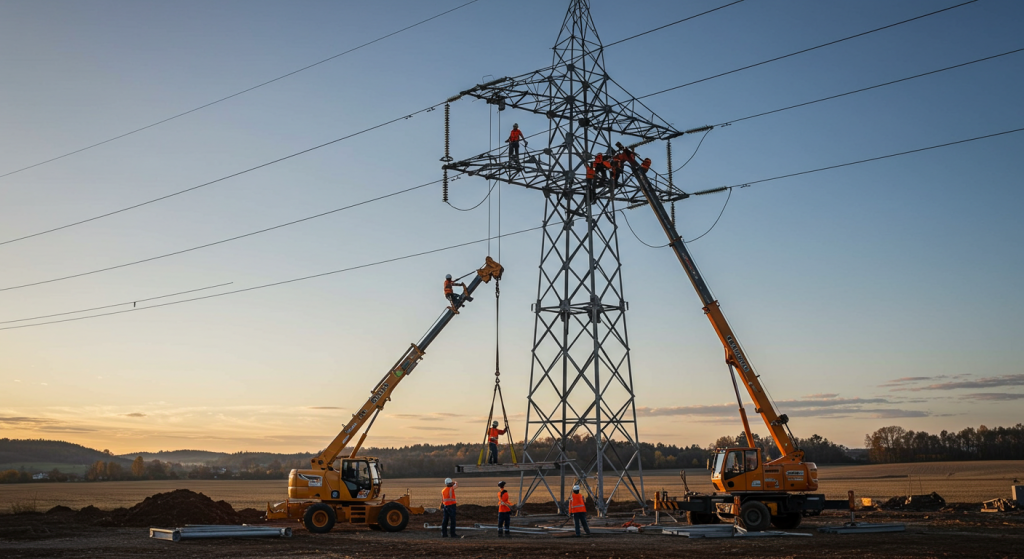Power Transmission Line Construction: Building the Energy Grid
2025-03-21
Power Transmission Line Construction: A Comprehensive Guide to Building the Backbone of Energy Infrastructure
Power transmission line construction creates a set distance from the farthest suburbs to the busiest metropolitan areas. Energy reliability grids would not remain in existence without such foresight and implementation. They’re established by those who’ve been there—the veterans of the industry who know the business—from the safest construction endeavors to learned, avoidable mistakes stemming from personal disasters to environmental disasters.
What is Power Transmission Line Construction?
Power Transmission Line Construction refers to the act of constructing the systems that convey electricity from generation to distribution. This includes (but is not limited to) transmission systems—transmission towers, high voltage wires, substations, and interconnection systems for long-distance conveyance and reduced energy loss. The main materials involved in the line construction include transmission towers—metal or concrete edifices that support the wires and subsequently elevate the lines above the natural grade.
• Electrical Conductors:
The material (usually aluminum or copper) that carries the electrical energy traveling through the spans of wire.
• Insulators:
The ceramic or resinous materials keep the conductors from touching the poles and shorting out the system.
The Steps Involved in a Transmission Line Construction Project
A Transmission Line Construction Project is a compilation of steps that form a bigger, more extensive known construction project. The steps that are involved with this mega-construction project are.
- Project Planning and Design
Executing a transmission line project is no different than any other project at the start—design. Many engineers are at play, and the selected project itself determines what’s feasible where, and when, and what’s required for voltage levels, directional arrays, etc.
- Transmission Line Design:
The specifications for the power transmission lines project are rendered designs with expected voltage levels (110kV, 220kV, 400kV, 765kV), any expected environmental concerns, and required clearings.
- Line Routing:
The line is routed based on geographical feasibility to eliminate where it’s going to be most disruptive for humans, animals, and vegetation.
- Geotechnical Surveys:
This survey is conducted to assess soil conditions, which enables the engineers to finalize foundation requirements, pole positioning, and any other engineering factors.
2. Surveying and Right-of-Way Clearing
There is a precedent construction from a power transmission line. Without surveying, the path of the line could be off with anticipated overlap down the line and insufficient structural support of the line guaranteed.
- Line Surveying:
This is where the engineers use the blueprints to decide what the path of the power line will be.
- Right-of-way tree Clearing:
This refers to the cutting down of trees, brush, and other debris that get in the way of the transmission line to prevent any natural or human incursion coming later down the line to interfere with what should be the intended electrical flow.
3. Foundation Construction and Tower Erection
After the right-of-way is cleared and established, the foundations and the towers are constructed, with bases for these grounded in soil conditions, tower height, and geographical considerations.
- Tower Foundations:
Poured concrete or steel footings that support the weight of transmission towers, which are often quite tall.
- Tower Erection
Towers made of steel are built and erected by construction cranes and heavy equipment. This requires a substantial level of interfacing for support and adjustments.

4. Conductor Stringing and Insulator Installation
After the towers are erected, one of the subsequent major steps is the conductor stringing and installation of insulators.
- Conductor Stringing
Conductor stringing is the actual process of stringing electrical conductors between the spans of transmission towers, requiring unique equipment like stringing cranes, cable-pulling tools, and manual tools.
- Substation Build-Out:
Substations are created with transformers, circuit breakers, and other support devices needed to switch and control electric energy distribution at the beginning and end of most transmission lines.
5. Substation and Access Road Construction
Access roads are needed to service every location of transmission installation. Access Road Construction: Where access roads do not currently exist, access road construction occurs to allow for machinery to get in and to grade areas of maintenance when the transmission line is operational.
6. Commissioning and Testing
The line is tested before energization.
- Electric Safety Integration Test: The line must withstand over/under voltage; otherwise, if it breaks/drops out, an explosion occurs.
- Punch List: All bolts tightened and wiring/insulators to specification.
Equipment and Materials Used for Power Transmission Line Construction
The following equipment and materials are used in power transmission line construction:
- Transmission Towers:
The various structures that hold and harness the wires/conductors.
- Electrical Conductors:
Aluminum, copper, and composites for electrical conductors.
- Insulators:
Porcelain or composite is used to minimize electrical shorts.
- Hoisting Equipment:
Cranes, dozers, and backhoes are required to maneuver heavy materials and elevate structures.
- Stringing Equipment:
The cranes and pulling trucks position the conductors at the top of the towers for a transmission line.
Technical Considerations in Power Transmission Line Construction
When Physically Building A Power Transmission Line: A power transmission line is a complicated structure that requires much engineering to make. Thus, these are the engineering considerations for making the lines:
- Voltage Levels
Based on the voltage determined by the transmission line, related subsequent design and material needs change. Voltage levels are taken into consideration at typically 110kV, 220kV, 400kV, and 765kV.
- Safety and Regulatory Considerations
There are increased safety requirements for transmission line installation as live line safety is needed during proper installation and, subsequently, down the line.
- Other Considerations
Environmental considerations are assessed as to where transmission occurs and where power transmission ultimately ends up, which, of course, has an essentially related impact. Ultimately, they have problems with soil erosion, wildlife incursion, noise, and construction dust.
Safety and Regulatory Considerations
- Construction Safety Standards:
The rules and regulations ensure that workers are safe on site from PPE to fall protection to operation of equipment.
- Utility Safety Standards:
Utilities must comply with national/international electrical safety standards and regulations such as the National Electrical Safety Code (NESC) in the United States.
- High Voltage Safety Standards:
safety requirements were instituted to prevent electric shock, flames, and damage when working with high-voltage components.
Transmission line construction is all part of the progression of electric power in the modern age. Everything comes together with on-site surveying and the design team collaborating with the electrical engineers to create the puzzle and ultimately energize the high-voltage lines at the finish.
Conclusion
Power transmission line construction is almost an esoteric process, learned over time with the advances in technology, the safety features, and even the truly esoteric construction required to elevate these long transmission lines for miles on end. Explore more about transmission line construction with the pros at XY Tower and more.

Привет, я Чуньцзянь Шу
"X.Y. Tower: Надежные, инновационные решения для высококачественных башен и электрооборудования с профессиональным сервисным обслуживанием.
